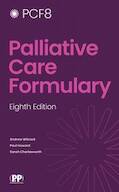
Palliative Care Formulary (PCF8)
Rif. 12-9780857114372
| 1u | 78,00 € |
Informazioni sul prodotto
Edited by Andrew Wilcock, Paul Howard, Sarah Charlesworth
Scheduled closure of pharmpress.com
ISBN 9780857114372
Published Aug 2022
DESCRIPTION:
The eighth edition of the Palliative Care Formulary (PCF), from Pharmaceutical Press, the Royal Pharmaceutical Societys knowledge business, is an essential resource for health professionals who care for patients with progressive end-stage disease. Although written primarily with cancer patients in mind, PCF8 contains specific material relating to several other life-limiting diseases e.g. COPD, end-stage heart failure, renal and hepatic failure, and end-stage Parkinson's disease. Grounded in clinical practice, this comprehensive title includes independent information about drugs used in palliative care, highlighting off-label indications or routes, and dealing with the administration of multiple drugs by continuous subcutaneous infusion. Updates in the new edition: Renamed monograph (Tricyclic antidepressants) and two discontinued - (Carbamazepine and Danazol). Fully reviewed and updated monographs including for: Individual strong opioid analgesic drug monographs and Quick Clinical Guides Antidepressants class and individual drug monographs Anti-epileptics class and individual drug monographs including a significantly updated section on the management of seizures and the use of subcutaneous levetiracetam Bisphosphonates monograph including the 2020 ESMO clinical practice guidelines and a new joint summary table for the indications of use for bisphosphonates and denosumab in palliative care Denosumab monograph including the 2020 ESMO clinical practice guidelines Drugs and fitness to drive chapter including updates to the summary table of the available evidence for sedative drugs Renal impairment chapter including significant changes to the sections on assessing renal function, and opioid use in renal impairment Drug administration to patients with swallowing difficulties or enteral feeding tubes chapter including a new step-wise approach for alternative formulations, and a fully updated table on commonly used alternative product Targeted updates to monographs including: H2-receptor antagonists monograph updated to reflect the alternative oral and parenteral options due to the world-wide absence of ranitidine Proton pump inhibitors monograph significant updates to the parenteral administration section Clonidine monograph, involving significant updates to the dose and use section and a new summary of dexmedetomidine use Drugs for diabetes monograph updated to include the 2021 Diabetes UK guidelines and the 2021 Joint British Diabetes Societies Inpatient Care Group guidelines. Significant changes to the sections on corticosteroid-induced diabetes mellitus, the management of hypoglycaemia, and the management of spikes of hyperglycaemia in the last few weeks of life Systemic corticosteroids significant updates on the risks of adrenal insufficiency including information about the new steroid emergency card and information on the evidence of use for appetite stimulation Anaphylaxis appendix updated to reflect the 2021 Resuscitation Council UK guidelines. PCF8 also includes several Quick Clinical Guides covering key topics in palliative care and designed for everyday use.
CONTENTS:
Preface
How PCF is constructed
Getting the most out of PCF
The use of medicinal products beyond (off-label) and without (unauthorized) marketing authorization
Drug names
Abbreviations
Part 1 Drug Monographs
1 Gastro-intestinal system
Antacids and antiflatulents
Antimuscarinics
Prokinetics
H2-receptor antagonists
Proton pump inhibitors
Loperamide
Laxatives
Topical products for haemorrhoids
Pancreatin
2 Cardiovascular system
Furosemide
Spironolactone
Systemic local anaesthetics
*Clonidine
Glyceryl trinitrate
Nifedipine
Anticoagulants
Haemostatics
3 Respiratory system
Bronchodilators
Inhaled corticosteroids
Oxygen
Drugs for cough
4 Central nervous system
Benzodiazepines and Z-drugs
Melatonin
Antipsychotics
Antidepressants
*Psychostimulants
*Cannabinoids
Anti-emetics
Anti-epileptics
5 Analgesics
Principles of use of analgesics
Adjuvant analgesics
Paracetamol
Nefopam
Non-steroidal anti-inflammatory drugs (NSAIDs)
Weak opioids
Strong opioids
Opioid antagonists (therapeutic target within the CNS)
Opioid antagonists (therapeutic target outside the CNS)
6 Infections
Antibacterials in palliative care
Oral candidosis
Metronidazole
Rifampicin
Urinary tract infections
Cellulitis in a lymphoedematous limb
7 Endocrine system and immunomodulation
Bisphosphonates
Denosumab
Systemic corticosteroids
Demeclocycline
Desmopressin
Drugs for diabetes mellitus
*Octreotide
Progestogens
*Thalidomide
8 Urinary tract disorders
Tamsulosin
Urinary antimuscarinics
Methenamine hippurate
Catheter patency solutions
Discoloured urine
9 Nutrition and blood
Anaemia
Ascorbic acid (vitamin C)
Vitamin K
Potassium
Magnesium
Zinc
10 Musculoskeletal and joint diseases
Depot corticosteroid injections
Rubefacients and other topical products
Skeletal muscle relaxants
11 Ear, nose and oropharynx
Mouthwashes
Artificial saliva
Pilocarpine
Drugs for oral inflammation and ulceration
Cerumenolytics
12 Skin
Emollients
Topical antipruritics
Barrier products
13 Anaesthesia
*Ketamine
*Propofol
Part 2 Prescribing in palliative care
14 Prescribing in palliative care
15 Anticipatory prescribing in the community
16 Prescribing for children
17 Renal impairment
18 Hepatic impairment
19 Variability in response to drugs
20 Prolongation of the QT interval in palliative care
21 Drug-induced movement disorders
22 Drugs and fitness to drive
23 Taking controlled and prescription drugs to other countries
24 Obtaining specials
25 Management of postoperative pain in opioid-dependent patients
26 Drugs for pruritus
27 Oral nutritional supplements
Part 3 Routes of administration
28 Drug administration to patients with swallowing difficulties or enteral feeding tubes
29 Continuous subcutaneous drug infusions
30 Transdermal patches
31 Nebulized drugs
32 Spinal analgesia
Appendices
A1Anaphylaxis
A2Opioid dose conversion ratios
A3Compatibility charts
Indexes
Drugs
Topics
REVIEWS:
From the reviews of previous editions
PCF [is] a core text for the speciality and has no serious rivals. Palliative Medicine
The information is up to date and prepared with extreme care. This handbook should be available to staff involved with inpatient consultation, inpatient units of care and home visits. Journal of Pain and Symptom Management
First class. Highly recommended. International Association for Hospice and Palliative Care
Proprietà chimiche
Richiesta tecnica su: 12-9780857114372 Palliative Care Formulary (PCF8)
Se si desidera richiedere un preventivo o effettuare un ordine, si prega invece di aggiungere i prodotti desiderati al carrello e poi richiedere un preventivo o un ordine dal carrello. È più veloce, più economico, e potrà beneficiare degli sconti disponibili e di altri vantaggi.





